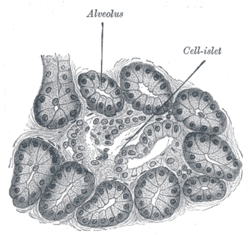Diabetes in dogs
Diabetes mellitus in dogs happens when the beta cells in the pancreas stop producing insulin (leading to type 1 diabetes) or produce enough insulin though cells improperly use it (leading to type 2 diabetes).
Diabetes in dogs can be treated. It doesn't need to make the life expectancies of dogs shorter than usual. If not treated, however, the condition could lead to cataracts, malnutrition, diabetic ketoacidosis, dehydration and possibly death.[1] Diabetes mostly affects middle-aged and older dogs. There are, however, juvenile cases.[2] The typical dog with diabetes is overweight or obese and middle-aged. Females are affected almost three times more often than male dogs.[3] But there are arguments about whether or not neutering male dogs may increase the risks of developing diabetes. Some data mention that male dogs' risks of becoming obese double or triple after they are neutered.[4]
Diabetes is commonly split into two types: type 1 and type 2.
Type 1 diabetes (previously called "juvenile diabetes") happens when the beta cells of the pancreas are either destroyed or severely damaged. The condition, in the past, was also called "insulin-dependent diabetes". That means insulin injections must replace the insulin the pancreas is no longer capable of producing for the body's needs. Type 1 is the most common form of diabetes and affects approximately 0.34% of dogs.[5]
Type 2 diabetes does develop in dogs. However, this form is not as common as type 1.[6][7] Because of this, there is no possibility the permanently damaged pancreatic beta cells could re-activate to bring about a remission (meaning no evidence of the disease) as may be possible with some feline diabetes cases. In cats, the usual type of diabetes is type 2.[8][9][10]
Gestational diabetes does happen in dogs. The condition, though, does not happen in dogs as often as for human beings.[11]
Genetic susceptibility of certain breeds
This list of risk factors for canine diabetes is taken from the genetic breed study. This study was published in 2007. The "neutral risk" category should be taken for being not enough evidence that the dog breed genetically shows a high, moderate, or a low risk for the disease. All risk information is based only on discovered genetic factors.[12][13]
|
High risk |
Moderate risk |
Neutral risk |
Low risk |
Diabetes In Dogs Media
Illustration of a dog's pancreas. Cell-islet in the illustration refers to a pancreatic cell in the Islets of Langerhans, which contain insulin-producing beta cells and other endocrine related cells. Permanent damage to these beta cells results in Type 1, or insulin-dependent diabetes, for which exogenous insulin replacement therapy is the only answer.
References
- ↑ "Diabetes in Dogs and Cats". Merck Veterinary Manual. Retrieved August 24, 2021.
- ↑ Catchpole, B.; Ristic, J. M.; Fleeman, L. M.; Davison, L. J. (October 2005). "Canine Diabetes Mellitus". Diabetologia. 48 (10): 1948–1956. doi:10.1007/s00125-005-1921-1. PMID 16151773. S2CID 22827221. Retrieved August 24, 2021.
- ↑ "Diabetes Mellitus in Dogs & Cats". The World Small Animal Veterinary Association. Retrieved August 24, 2021.
- ↑ "The Long-Term Health Risks and the Benefits Associated with Spay/Neuter in Dogs" (PDF). NAIA Online. Retrieved August 24, 2021.
- ↑ Mattin, M.; O'Neill, D.; Church, D.; McGreevy, P. D.; Thomson, P. C.; Brodbelt, D. (5 April 2014). "An epidemiological study of diabetes mellitus in dogs attending first opinion practice in the UK" (PDF). Veterinary Record. 174 (14): 349. doi:10.1136/vr.101950. PMID 24570406. S2CID 22828246.
- ↑ "Type 2 Diabetes & Symptoms in Dogs". The Vet Info. Retrieved Sep 23, 2019.
- ↑ "Diabetes in Dogs". Top Dog Tips. 13 August 2018. Retrieved Sep 23, 2019.
- ↑ Vetsulin. "Difference Between Type 1 and Type 2 Diabetes". Intervet. Archived from the original on March 24, 2013. Retrieved 17 March 2010.
{{cite web}}: CS1 maint: unfit URL (link) - ↑ Greco, Deborah. "Ask Dr. Greco". BD Diabetes. Retrieved 17 March 2010.
- ↑ Rand, Jacqueline; Marshall, Rhett (2005). "Understanding Feline Diabetes Mellitus". Centre for Companion Animal Health, School of Veterinary Science, The University of Queensland, Brisbane, Australia. Retrieved 17 March 2010.
- ↑ "Gestational Diabetes Mellitus in Dogs". The Journals of Veterinary Internal Medicine. Retrieved August 24, 2021.
- ↑ Short, AD; Catchpole, B; Kennedy, LJ; Barnes, A; Fretwell, N; Jones, C; Thomson, W; Ollier, WER (23 July 2007). "Analysis of Candidate Susceptibility Genes in Canine Diabetes". Journal of Heredity. 98 (5): 518–525. doi:10.1093/jhered/esm048. PMID 17611256.
- ↑ Short, Andrea D., Catchpole, B., Holder, AL, Ollier, William E.R,, Kennedy, LJ (21 December 2012). "Genetics of canine diabetes mellitus: are the diabetes susceptibility genes identified in humans involved in breed susceptibility to diabetes mellitus in dogs?". Veterinary Journal. 195 (2): 139–47. doi:10.1016/j.tvjl.2012.11.013. PMID 23265864.
{{cite journal}}: CS1 maint: multiple names: authors list (link)[dead link]


